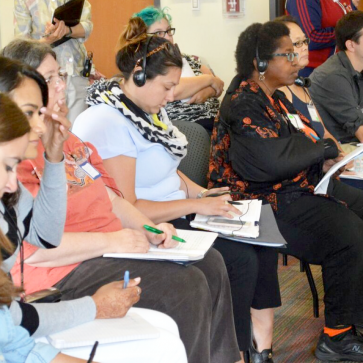Lesson Study works best with rich subject content. This course offers step-by-step support to conduct a Lesson Study cycle on fractions, by providing fractions resources and research to examine.

“A lesson is like a swiftly flowing river; when you're teaching you must make judgments instantly. When you do a research lesson, your colleagues write down your words and the students' words. Your real profile as a teacher is revealed to you for the first time.”
- A teacher from Japan
Logistics Before the Day of the Research Lesson
It is almost time for the most interesting part of any research effort—seeing how your ideas fare in practice. The data collected by the observers will enable you to slow down the “swiftly flowing river” of instruction in order to study it.
Now that your Teaching-Learning Plan is complete, you can take care of some additional logistical items.
Agree on which team members will collect each item you listed under “Data to Collect” in your Teaching-Learning Plan. Prepare any needed data collection forms, such as multiple copies of the seating chart (to record students’ solutions or strategies), or copies of the Lesson Observation Notes, customized to capture your team’s questions.
Prepare to collect any additional materials that will help you understand the lesson, such as still photographs and student work.
Prepare to observe the lesson by reviewing the Protocol for Lesson Observation below. It deserves careful review by each team member and each observer of the research lesson, since the type of observation and discussion expected during lesson study is usually a departure from the familiar. The role of the observers during lesson study is to collect data. As U.S. researchers have noted, the observers are supposed to function as "an extra set of eyes, not an extra set of hands." When observers help students, it’s difficult to draw inferences about how well the lesson worked.
Prepare students by letting them know in advance that the extra teachers in the room will be studying the lesson, not helping the students. This way, students won’t think they’ve encountered a roomful of exceptionally unhelpful adults! Let the students know that adults are in the room to learn about lesson design and teaching—to learn from the students, not to evaluate them.
Support the instructor. Since the teacher actually teaching the lesson already shoulders considerable responsibility, other group members will want to divide up responsibility for support tasks like the following:
- Obtain needed materials for the lesson (e.g., chart paper, tape);
- Prepare enough copies of the Teaching-Learning Plan, the Protocols for Observation (below) and Post-Lesson Discussion (in the Reflect phase), and the Lesson Observation Notes for team members and any outside observers;
- Designate who will facilitate the post-lesson discussion and designate the time for each part of the discussion (an outside facilitator is helpful if observers beyond the team will be present); and
- Take notes during the post-lesson discussion.
On the Day of the Research Lesson
Please make sure each team member and additional observers have a copy of the Protocol for Lesson Observation and the Teaching-Learning Plan. Make sure that observers outside the team carefully read your Teaching-Learning Plan, review the Protocol, and know what data to collect.
Teach and Observe the Lesson
It is now time for the most interesting part of your Lesson Study cycle—seeing how your ideas fare in practice in the classroom.
Protocol for Lesson Observation
- Respect the classroom atmosphere. For example, silence phones, refrain from side conversations, arrive on time, and stay for the entire lesson.
- Do not help students or otherwise interfere with the natural flow of the lesson. For example, be careful not to block students’ view when they need to see the board or the teacher.
- Collect data requested by the lesson planning team, or focus on the “points to notice” laid out in their instructional plan. Prepare by reading the lesson plan thoroughly.
- Focusing on the same student (or pair of students) over the entire lesson is likely to yield the best picture of whether and how the students developed understanding.
- If the lesson study team concurs, it is all right to ask clarifying questions of a student after the lesson has concluded.

